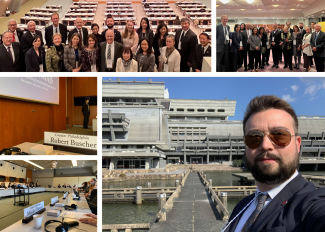
A Visit to the International Symposium of America-Japan Societies in Kyoto by Rob Buscher
12/1/2022
Outside of my scholarly work at Penn’s ASAM program, the past decade-plus of my career has focused mainly on non-profit administration in the Japanese American and broader Asian American community spaces. However, since the summer of 2021 I have been working for the Japan America Society of Greater Philadelphia (JASGP), a nonprofit organization that seeks to inspire mutual curiosity, understanding, and collaboration between Japan and the Greater Philadelphia region through citizen diplomacy. We operate Shofuso Japanese House and Garden, produce the Philadelphia Cherry Blossom Festival, present a US-Japan Business and Public Policy Series, and provide Japanese arts, cultural, and educational programming for all ages.
While this is a fairly significant departure from my past work, it is actually more relevant to my academic background in Japan Studies that any job I have held to-date. The past year and a half working for JASGP has reminded me why I, as a mixed-race Japanese American, decided to pursue the field of Japan Studies in the first place, before making the shift to Asian American Studies.
I recently had the opportunity to represent JASGP at the international symposium organized by the America-Japan Society of Kyoto, which was my first work related engagement in Japan, aside from chaperoning a couple of school trips. This felt like a homecoming of sorts, since Kyoto was the city where I first lived in Japan during the summer of my Senior year of undergrad, and again when I was conducting research for my Master’s Thesis, which dealt with the cinema of occupied Japan from 1946-1952.
This was my first visit to Kyoto since 2016, which is not a terribly long amount of time between visits abroad, but in the early months of the pandemic, I found myself questioning whether I would ever be able to visit Japan again given the uncertainty and anxiety around prolonged border closures. Returning to Japan was a cathartic experience that allowed me to shed a lot of the pandemic stress that I had been carrying around with me these past few years, and reinvigorated my interest in working to bring our countries and people closer together.
Likewise, as a scholar of Asian American Studies, my closeness to Japan has allowed me to expand the discourse within my courses to include perspectives and content that address both Japanese and Japanese American histories, cultures, and experiences in ways that explore the sometimes-subtle nuance between diasporic cultural practice and ancestral culture of origin. With each visit to Japan, I find my appreciation for certain elements of the culture continues to deepen in new and unexpected ways.
In this sense I find the Japanese concept of kaizen or continual refinement to be particularly apt in describing my own relationship to Japan. The more that I learn, the more I realize there is left to discover. Likewise, I would also use kaizen as a metaphor to describe what the ideal US-
Japan relationship should look like. In terms of the bilateral relationship, our two nations have never been closer than they are today. However, to think that this means no attention is needed to build or strengthen this relationship would prove a critical oversight.
Compared to the bubble economy years, American students are less interested in studying or working in Japan. Japanese immigration policy is largely to blame for this, as it is notoriously difficult to get a permanent visa to live and work in Japan as a non-citizen, so many college students forgo it as a realistic possibility for post graduate employment. From the Japanese perspective, there are also fewer reasons to go abroad when the aging population of Japan has resulted in an unprecedented number of job openings in their own domestic economy. Considering how safe Japan is compared to the US, risk-adverse Japanese citizens may be further deterred from venturing overseas amid the rise in anti-Asian violence. There is also the matter of the isolationist mentality that has developed in reaction to the COVID lockdowns, which is a factor in both Japan and the US.
Now that the travel restrictions have been lifted to allow easier entry into Japan, the Kyoto Symposium I attended was the first opportunity for the US-based Japan America Societies and Japan-based America-Japan Societies to hold a joint meeting since the COVID pandemic began. The meeting started with a formal introduction from each representative organization, sharing details on our current program areas and recent developments amid the pandemic.
After the joint meeting concluded our delegation participated in a day-long summit with policy experts and diplomatic officials weighing in on issues related to security in the Indo-Pacific region, challenges and opportunities in bilateral relations during the COVID pandemic, and best practices for strengthening US-Japan relations on a local level. One of the speakers made an analogy that I thought to be quite profound. Although US-Japan relations are the best they have ever been, like a garden, the relationship needs regular tending to ensure its continued prosperity.
Particularly as a Japanese American, I find it deeply satisfying to be involved in this work. I encourage others within our Asian American community to consider how they might become more involved in strengthening and maintaining the relationships with each of our ancestral cultures of origin. If nothing else you may gain additional perspective that allows you to appreciate nuance within your own cultural practice.
